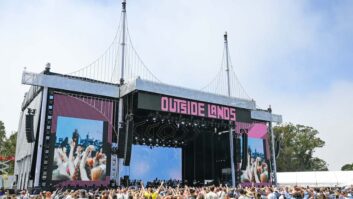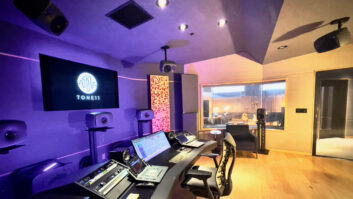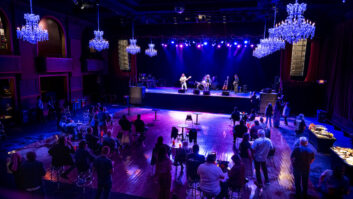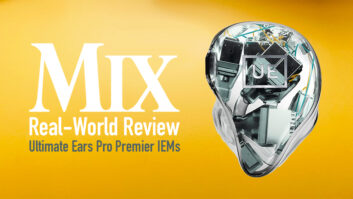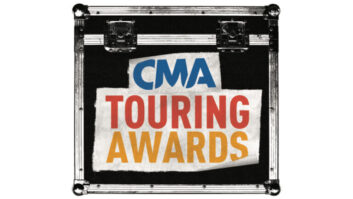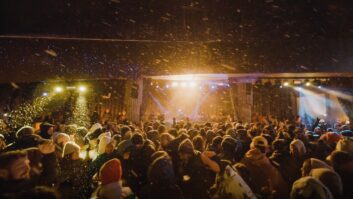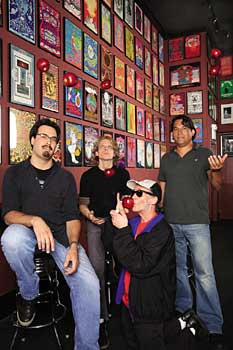
At the Fillmore, from left: Sound techs Mary Alafetich,
Bobby Mack, Nathan Harlow and Zombie
All photos: Steve Jennings
THE FILLMORE
What once hosted Wednesday night social and masquerade balls (1912), was a dance hall (up through the 1930s) and a roller rink (1940s), The Fillmore has been through numerous incarnations as a music venue: It hosted James Brown and other R&B greats in the late ’50s and early ’60s, then was the center of the San Francisco psychedelic renaissance under Bill Graham from late ’65 to 1968. It lay dormant for many years and then came back as a first-call venue run by Graham’s company in the late ’80s and then again from 1994 on. For a complete history, visit www.thefillmore.com.
At FOH is a Crest Century X VCA 48×8×2, while monitors get a Crest Century LMX (40×20) at stage-right. The P.A. comprises three Meyer M3D powered line array (flown) per side, three Meyer M3D powered line array subs per side, a Meyer DF-4 powered in-fill per side (underhung) and one flown Meyer CQ-2 for center-fill. Monitors include Meyer wedges and sidefills with BSS EQ, Aphex and Klark-Teknik gates, and Crest amps. Outboard gear includes models from TC Electronic, Yamaha, dbx, Summit, XTA, BSS and more.

Great American Music Hall’s Lee Brenkman, senior sound tech
GREAT AMERICAN MUSIC HALL
Looking back to a more elegant time period, this 50,000-square-foot mid-sized club — with its ornate balconies, soaring marble columns and elaborate ceiling frescoes — opened in 1907 as Blanco’s during the height of San Francisco’s Barbary Coast era. Thirty years later, Sally Rand brought new life to the building — renaming it Music Box — until it turned out its lights at the end of World War II. Blanco’s reopened in 1948 as a jazz club, and in the 1950s, the Moose Lodge took over management. In 1972, the Great American Music Hall opened as it stands now. The venue’s main speaker system (JBL Array Series and Crest amps) has been in place since 1989/90; the owners are contemplating an upgrade. Other gear includes a Soundcraft K2 40-channel FOH board, JBL processors, a Soundcraft Delta Monitor 32×10, McCauley wedges, a plethora of outboard gear and mics from Audix, Audio-Technica, AKG, Shure, Sennheiser and Countryman.

THE WARFIELD
Named for veteran actor David Warfield, this theater is one of the last surviving vaudeville palaces of the 1920s. Its Victorian heritage can still be seen today with its ornate ceiling designs, elegant chandeliers and wrought-iron balustrades. Gold-leafed opera boxes (unused today) overlook the stage and the period mural over the proscenium. After recent renovations, the Warfield has become a must-play destination for national acts such as Ryan Adams, PJ Harvey, Interpol and many other up-and-coming bands. While the venue does not offer an in-house system (typically, most bands playing the venue are carrying their own rig), audio tech riders can be met via rentals from local companies such as UltraSound/Promedia and Sound on Stage.

From left: monitor engineer Damien Rasmussen, FOH engineer Steve Foyliani and Scott Burke (production)
BIMBO’S 365 CLUB
Bimbo’s 365 Club co-founder Agostino Giuntoli left Tuscany in 1922, sailed to America and began working as a janitor and then a cook in San Francisco’s Palace Hotel. His boss, Monk Young, was unable to pronounce his name and referred to him as “Bimbo,” the Italian word for boy. The name stuck. In the midst of the Great Depression, he and Young opened the 365 Club, moving to the present locale in 1951.
A Midas XL-200 takes centerstage at FOH with processing via Klark-Teknik DN360 and DN410, BSS OmniDrive and DPR-402, dbx 1046 and 166, and a Summit stereo tube compressor. Monitor engineers can take stock of the Soundcraft M3 board, Audio Logic graphics, 10 Sound on Stage wedges with JBL drivers and woofers (UREI crossovers at 1,200 Hz and time-offset correction) and Crest power amps. The P.A. is a Nexo system comprising two M3/two B1 (left, flown), two PS15 (center, flown), two M3/two B1 (right, flown), two B1/S2 (left and right, ground) and Meyer UPAs for rear and mid-room delays. Bimbo’s mic closet is stocked with models from Beyer, Sennheiser, Audio-Technica, Shure and AKG. A six-foot Kawai baby grand is also on-hand.

Audio engineer Thilo Fehlinger (left) and Gabe Nahshon, sound tech
THE POUND
The Pound is currently expanding into an indoor/outdoor venue, with the upgrade including a new 8-channel Crest X-Eight for FOH. The production for the outside venue (2,000 capacity) will at first be covered by rentals with plans to purchase a house-owned system. The Pound offers Soundcraft Spirit LX-7 boards (FOH, 32-input; monitors, 24-input located at FOH) for incoming audio engineers. Mains are provided by Apogee AE-9s (one per side), double-18s (one per side) and single-18s (two at center), with Apogee digital processor amps matched to speakers. Monitors are via four Yamaha SM 15-IV with Crest and QSC amps, a self-powered Mackie SR 1530 (drumfill) and two Apogee AE-5 sidefills. Outboard gear includes models from Ashly, dbx, Drawmer, PreSonus, TC Electronic and Lexicon, while the mic closet is stocked with Shures, Sennheisers and AKGs.

Slim’s audio department manager Tigi Coyle
SLIM’S
Opened in 1988 by R&B artist Boz Scaggs, Slim’s attracts all types of music, nationally and internationally. The premises comprise an open floor on the main level with a performance stage on one end, a small balcony with table seating at the other end and a full bar running the length of the room. House specs include Soundcraft Vienna 40-channel FOH board and a Yamaha 3210 at monitor world. Processing includes BSS Omnidrive with BSS FDS 388 Omnidrive and Klark-Teknik DN360 graphic EQ (FOH) and BSS FDS 334 Minidrive and eight BSS FCS 960 (monitors). The JBL array system comprises four 4894s (two per side, flown; each box loaded with 2×14s and 1×½), with two sub boxes per side (each box loaded with dual-18s) ground-stacked — all JBL powered — and JBL wedges. Microphones run the gamut from Sennheiser, AKG, Shure and Audio-Technica.

Bottom of the Hill’s sound techs, from left: Ben Tuttle, Lars Savage and Kim Griess
BOTTOM OF THE HILL
Presenting live music shows seven days a week, the Bottom of the Hill has hosted top-notch acts including Bad Religion, Nashville Pussy, Fu Manchu and The Donnas, while spotlighting up-and-coming local bands. Artists can be heard through EAW ASR 695 bi-amped mains, which have recently been upgraded with 1,000-watt woofers, all powered by Crest 7001 amps. Front-of-house engineers can use the venue’s Allen & Heath GL3000 24-channel board; outboard gear comprises TC Electronic M1, Yamaha Rev-500, Roland SDE-1000, dbx 266 compressor/gates, Drawmer 241 compressor/gates, Symetrix compressor and AL gates. For monitoring, the venue provides four discrete mixes (three front, one drumfill) of Community boxes powered by Crest amps, as well as two Community VBS415 subs powered by a Crown MacroTech 5000 amp.

Ruby Skye sound tech Dan Thiel
RUBY SKYE
Located in the heart of the theater district, Ruby Skye offers live shows and DJ music every Friday and Saturday with special events held on Wednesday, Thursday and Sunday nights. Built in the 1890s, Ruby Skye is a historical landmark (a turn-of-the-century Victorian playhouse) that formerly housed The Stage Door Theatre. San Francisco — based JK Sound recently installed a new BSS SoundWeb system, which is set up in a four-corner configuration, in which the two left and right rear speakers are facing the stage. In Live mode, the rear speakers are muted and the equalization of the front speakers is changed so that the vocals are better projected. The Live setting also allows the engineer to send a mono mix to a center cluster that functions as the balcony fill, as well as redirect the inputs to a pair of stagefill speakers that can then be used as sidefill monitors. Additionally, the Live setting switches the input to the subs from a stereo sum of the Rane MP2016 DJ mixer to a line that can be fed by an aux from the mixing board; the subs are built into the front of the stage. The main dancefloor’s five-way system has four JBL VS3215-9 speakers, four JBL SPL125 speakers, two JK Sound quad 18-inch subs with JBL 2242 drivers — all driven by QSC CX502/702/1102 and PL 4.0 and 6.0 amps.

The Independent’s FOH engineer, John Karr
THE INDEPENDENT
The Independent (formerly the Justice League) is a 500-capacity club that’s been completely renovated to handle everything from hip hop superstars to blaring indie rockers. Its state-of-the-art sound system features a Midas Legend 3000 FOH console and a digitally optimized Electro-Voice X-Array P.A. system (including P3000RL remote-controlled amps with digital speaker management). The FOH console and lighting console are located in a dedicated15×9-foot “tech space,” located directly between the mains and approximately 50 feet from the front of the stage. The stage-level monitor area hosts a Soundcraft 500B 32×12 console with custom 6dB momentary feedback kill switch. Monitors are brand-new Electro-Voice XW15 wedges driven by CP2200 precision amps and tuned via a Klark-Teknik DN8948 speaker-management system and dual ⅓-octave EQs. A monitor patch system includes a 12-channel snake from the Soundcraft’s outputs to a panel mounted on the front of the monitor amp rack, allowing the engineer to assign any mix to any amp channel. As the venue is located in a residential area, a 105dB SPL limit on the mixes (measured from FOH) is enforced.

DNA Lounge’s mix board and DJ setup
DNA LOUNGE
The crew at DNA Lounge recently spent a year remodeling (including soundproofing to code) what was essentially a dive bar with a nice stage. The DNA Lounge’s main room has a brand-new, state-of-the-art DJ/live music 17,000-watt sound system that is controlled and routed via a pair of BSS SoundWeb 9088 MKII 8×8 digital processors. The DJ station, FOH board and lighting station are located on a raised platform above the dance floor, with a clear view of the main room. A second sound system located upstairs can run as an independent system or slaved to the main room. The main room’s FOH system includes EAW speakers, Crest amps, a Soundcraft 32-channel Series II board and a plethora of outboard gear. Stage and monitoring duties are handled by a 32-channel Soundcraft Spirit 8 board, dbx 2231 EQs, EAW wedges and sidefills, Community drumfills, and Crown Macrotech and Crest amps. Microphones include models from Sennheiser, Shure and BSS. As part of the retrofit, audio (streaming MP3) and video (RealVideo) Webcasts are beamed over the Net every night.
